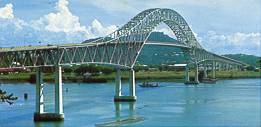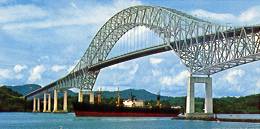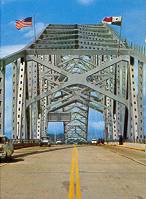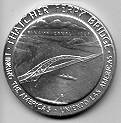The inauguration of the Bridge of the Americas


From the beginning of the works in the canal by the French, it was noted that there would be a break in the link between the cities of Panama and Colon with the rest of the republic, once the country was split in two parts.
With the arrival of the Americans in 1904, as the new leaders in the struggle to carry forth this monumental task, the transportation problem became increasingly greater. This situation was solved in part by transit on the barges that crossed the Gatun locks area.
As the population increased, on the works of the canal as well as in the Republic itself, the difficulty of traveling to the interior became even more acute.
The Panama Canal logo bears the phrase, "the land divided, the world united", meaning clearly that Panama had been dismembered for the benefit of the world.
In response to the large number of automobiles and a central highway—soon to be inaugurated--that led all the way to Chiriquí, the Panama Canal Mechanical Division built two ferries (Presidente Amador and Presidente Washington) in August 1931, to ferry back and forth from both shores of the Canal.
In August 1940, another similar service was begun with barges powered by gasoline engines, mainly to serve military operations and meet the needs of new townsites and installations of the US Army and Navy, as a result of World War II.
On June 3, 1942, the Miraflores swing bridge was concluded, which would somewhat alleviate this problem.
By November 1942 another ferry was added, Presidente Porras, in response to the marked increase in vehicular traffic.
The idea of a bridge spanning the Canal to allow continual and unimpeded flow of vehicles and individuals had been held for many years. In 1923 it was proposed by the Panamanian government as an incontrovertible priority.
The canal treaty that was negotiated by President Rodolfo Chiari in 1926 had, among its issues, the building of a bridge over the canal, but was conditioned to the establishment of a network of roads nationwide.
The subsequent administrations of Presidents Harmodio Arias (1934), Arnulfo Arias Madrid (1941), and Ricardo Adolfo de la Guardia (1943), gradually moved toward the objective of the bridge over the canal, each one achieving something toward this aspiration.
 With the signing of the
Remón-Eisenhower treaty in 1955, the northern nation finally made a
commitment to build the bridge.
With the signing of the
Remón-Eisenhower treaty in 1955, the northern nation finally made a
commitment to build the bridge.
The $20,000,000 contract was awarded to John F. Beasly & Company, who worked very efficiently to meet the inaugural date of October 12, 1962.
The Americans always called it the Thatcher Ferry Bridge, while Panama used the name Bridge of the Americas, which was made official in a National Assembly Resolution of October 2, 1962. The resolution read as follows:
"The bridge over the Panama Canal shall bear the name Bridge of the Americas.
"Said name will be used exclusively to identify said bridge.
Panamanian government officials shall reject any document in which reference is made to the bridge by any name other than "Bridge of the Americas."
A copy of this resolution, with the appropriate note on style, shall be forwarded to all legislative bodies of the world, so that all may give the bridge the name chosen by this honorable assembly, complying with the express will of the Panamanian people.
Given in the city of Panama on the second day of the month of October of nineteen hundred and sixty-two.
| President, Jorge Rubén Rosas |
|
| Secretary, Alberto Arango N." |
The bridge is 5,425 feet long with a span of 348 feet above sea level and 201 above the highest possible tide.
The bridge has an arched steel structure and on both ends there are wide access ramps in both directions and a pedestrian walkway on each side.


On inaugural day, the U.S. Army and Air Force bands as well as the Panama National Guard Band gave a concert at 9 a.m.
The program began at 9:30 a.m. and consisted of the following items:
- Invocation by Reverend Mainert J. Petersen
- Speech by Max DelValle, Minister of Panama Public Works
- Prayer by Rabbi Nathan Witkins, Director of the Board of Jewish Affairs
- Musical Presentation: Hymn of the Americas by the choir of the Army and Air Force School for Latin America.
- Introductory remarks by Governor Fleming
- Speech by the Honorable Under Secretary of State, George W. Bell
- Presentation of the Bridge by John F. Beasly to Colonel Matthew C. Harrison and Governor Fleming
- Words by the Honorable Maurice F. Thatcher
- National Anthem of the United States of America
- National Anthem of the Republic of Panama
- Benediction by Monsignor José María Carrizo, Prelate of Panama
- Cutting of the Ribbon by Maurice F. Thatcher
- The Thatcher Ferry Bridge March, a joint presentation by the bands of the United States Air Force and Army.
This ceremony had full nationwide coverage on radio and television. The Canal Zone station was the anchor for the networking channels (2, 4, 8, & 10).
Many precautions were taken to avoid crowding and to preserve the order during the entire ceremony.
After the ceremonial protocols, those in attendance were allowed to walk across this modern structure.
The Canal Zone Postal Administration issued a postal seal with a picture of the bridge and the caption:
THE THATCHER BRIDGE UNITING THE CONTINENT
1962
THE PANAMA CANAL UNITING THE OCEANS
1914
It is worth noting that the undersecretary of the northern nation in his speech said, "we can look today to this bridge as a new and bright step toward the realization of that dream of a Pan-American Highway, which is now almost a reality. The grand bridge we inaugurate today—truly a bridge of the Americas—completes the last stage of the highway from the United States to Panama". He referred to the new structure as "truly a bridge of the Americas", either inadvertently or in a very political fashion, supporting the name chosen by the Panamanians.
A special guest also was the 99-year-old episcopal clergyman, Edward J. Cooper, who worked for the canal agency for 35 years.
The great curiosity over the new bridge and the desire of everyone to cross it, created initially great traffic jams, which brought about the opening of the Miraflores bridge to ease the flow of vehicular traffic.
After the first few days, the situation was normalized and the majestic Bridge of the Americas has proudly continued her symbolic and practical task of uniting the Republic of Panama.
This inauguration was the crowning moment in an enormous, collective triumph of efforts and wills throughout the years.
Truly a watershed moment for the people of Panama.